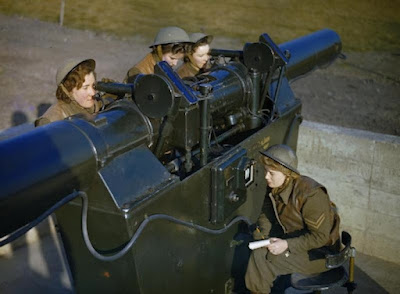Adjacent to the Royal Artillery Garden is the Auxiliary Territorial Service / ACK ACK memorial which remembers the service of the Ack Ack Girls in the Royal Artillery. |
| ATS Ack Ack Girls Memorial National Memorial Arboretum |
The ATS - Auxiliary Territorial Service - was formed 1st February 1938 as the woman's branch of the British Army purely as a volunteer service.
 |
| ATS Recruiting Exhibition Selfridges Oxford Street London (C) IWM H3759 |
The women were employed as cooks, clerks, telephonists and storekeepers. In 1940, 300 ATS deployed with the British Expeditionary Force to France. During the evacuation from Dunkirk some of the ATS telephonists were last to leave France.
As the war progressed and more manpower was required for combat arms, the roles performed by the ATS expanded. Women began to augment Heavy Anti-Aircraft Regiments of the Royal Artillery. The first ATS personnel began their training in early 1940. Formed troops of ATS personnel operated technical equipment such as identification telescopes, predictors, height finders, radars, and worked on plotting tables.
 |
| ATS spotter with binoculars at an anti-aircraft command post (C) IWM TR 453 |
 |
| ATS girls using an identification telescope (C) IWM TR469 |
 |
| The Predictor team of ATS girls at work (C) IWM TR475 |
 |
| ATS girls working the Kine-Theodolite It photographs shell bursts checking the results of Predictor crews. (C) IWM TR 457 |
 |
| ATS girls operating the height and range finder (C) IWM TR 474 |
 |
| ATS working in the plotting room at an anti-aircraft gun site (C) IWM H 26576 |
In April 1941 54 ATS personnel were sent to be trained on searchlights to assess their suitability for the role. The 'Newark Experiment' was a success and in December 1941 the War Office recommended that members of the ATS could be used for operational searchlight duties.
 |
| ATS Searchlight Operators |
The first mixed units of the Royal Artillery began to be formed from August 1941 onwards. The first Mixed Regiment was 131 (Mixed) HAA Regiment RA. The first searchlight mixed unit was 26th (London Electrical Engineers) Searchlight Regiment RA.
Parliament introduced the National Services Act in December 1941 which called up unmarried women between the age of 20 and 30 years old to join one of the auxiliary services. The success of the incorporation of ATS women into Artillery Units raised the question of how the newly conscripted women would be utilised. Winston Churchill, addressing Parliament, stated "I want to make it clear that a woman may be compelled to join the ATS, but only volunteers from within the ATS will be allowed to serve the guns".
Winston Churchill's daughter Mary would be one of those to volunteer, serving as an ATS Officer in Ack Ack Command.
In October 1942 the only all female Regiment was formed, 93rd (Mixed) Searchlight Regiment Royal Artillery. The Commanding Officer and Battery Commanders were male.
 |
| 93rd Searchlight Regiment RA Re-enactment Group |
The number of mixed HAA units would eventually number fifty one Regiments. There would be sixty seven mixed Searchlight Batteries, with a further 117 Searchlight Batteries operating with ATS support. By 1944, 76,000 women of the ATS were serving in Anti-Aircraft Command.
 |
| A battery of 3.7 inch anti-aircraft guns firing at night. ATS Gun Site (C) IWM TR 478 |
"When the barrage opens out to meet the invading hun
The Ack Ack Girls of the ATS also made the ultimate sacrifice.
On 17th April 1942 18 year old Private Nora Caveney became the first ATS Gunner to be killed on active service. She was hit by a bomb splinter whilst operating a predictor.
Serving with 505 Battery, 148 (Mixed) Regiment, Nora Caveney, from Walsden West Yorkshire, was killed when a bomb was dropped on the gun site the Battery occupied at Westwood Camp near Southampton.
Nora Caveney is buried in Netlely Military Cemetery, Hampshire.
Everybody's thoughts go out to the Girls Behind the Guns
But they are not the only girls in the frontline every night
For suddenly from out of nowhere comes a blinding light
A long accusing finger pointing upwards to the sky
To tell the guns and fighters "there the raiders lie"
They're the Girls that do a job - A far from easy one
But equally important in keeping off the hun
Unloved, unwanted - fact few people know
That when the beams are out at night the girls are down below
But if they help in some small way to keep the hun at bay
They're satisfied
And don't give two hoots what people say"
The Ack Ack Girls of the ATS also made the ultimate sacrifice.
On 17th April 1942 18 year old Private Nora Caveney became the first ATS Gunner to be killed on active service. She was hit by a bomb splinter whilst operating a predictor.
Serving with 505 Battery, 148 (Mixed) Regiment, Nora Caveney, from Walsden West Yorkshire, was killed when a bomb was dropped on the gun site the Battery occupied at Westwood Camp near Southampton.
 |
| Private Nora Caveney Auxiliary Territorial Service attached. Royal Artillery |
Nora Caveney is buried in Netlely Military Cemetery, Hampshire.
------0------

































